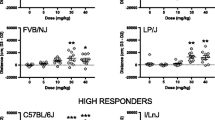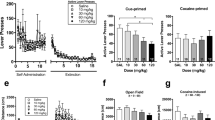Abstract
Rationale
Fischer 344 (F344) and Lewis (LEW) rats differ in cocaine self-administration behaviors. Whether or not these inbred strains of rats differ in pharmacological reinstatement of cocaine-seeking behavior is unknown.
Objectives
The purpose of the present study was to determine if inbred strains of rats demonstrate differences in alpha-amino-3-hydroxy-5-methylisoxazole-4-proprionic acid (AMPA) and cocaine-induced reinstatement of previously extinguished cocaine-seeking behavior.
Methods
F344 and LEW rats received indwelling jugular catheters, bilateral guide cannula aimed at the nucleus accumbens core, and were trained to lever press for 0.5 mg/kg intravenous cocaine during 2-h self-administration sessions. Following 14 sessions, rats underwent extinction sessions, where previously reinforced lever pressing resulted in no programmed consequences. Just prior to beginning extinction session 7, rats received an intracranial infusion of saline. Lever pressing was not reinforced. During subsequent extinction sessions, rats received AMPA injections (0.2, 0.4, or 0.6 nM). Dosing order was determined by a within-subject Latin square design. At least two extinction sessions separated each AMPA session. Rats then underwent cocaine-induced reinstatement test sessions (lever pressing was not reinforced). Rats received passive intravenous cocaine (0.0, 0.5, 1.0, or 2.0 mg/kg) after being placed in the experimental chamber. At least two extinction sessions separated each cocaine-prime session, and subjects were tested at each dose according to a within-subjects Latin square design.
Results
LEW rats demonstrated blunted maximal responding to AMPA-induced reinstatement and heightened sensitivity to cocaine-induced reinstatement compared with F344 rats.
Conclusions
This study demonstrates that inbred strains differ in pharmacological reinstatement of cocaine-seeking behavior.





Similar content being viewed by others
References
Ahmed SH, Koob GF (1998) Transition from moderate to excessive drug intake: change in hedonic set point. Science 282(5387):298–300
Baker DA, McFarland K, Lake RW, Shen H, Tang XC, Toda S, Kalivas PW (2003) Neuroadaptations in cystine–glutamate exchange underlie cocaine relapse. Nat Neurosci 6(7):743–749
Carroll ME, France CP, Meisch RA (1979) Food deprivation increases oral and intravenous drug intake in rats. Science 205(4403):319–321
Comer SD, Lac ST, Wyvell CL, Curtis LK, Carroll ME (1995) Food deprivation affects extinction and reinstatement of responding in rats. Psychopharmacology 121:150–157
Cornish JL, Kalivas PW (2000) Glutamate transmission in the nucleus accumbens mediates relapse in cocaine addiction. J Neurosci 20(15):RC89
Cornish JL, Duffy P, Kalivas PW (1999) A role for nucleus accumbens glutamate transmission in the relapse to cocaine-seeking behavior. Neuroscience 93(4):1359–1367
Crabbe JC (2002) Genetic contributions to addiction. Annu Rev Psychol 53:435–462
de Wit H, Stewart J (1981) Reinstatement of cocaine-reinforced responding in the rat. Psychopharmacology 75(2):134–143
de la Garza R, Bergman J, Hartel CR (1981) Food deprivation and cocaine self-administration. Pharmacol Biochem Behav 15(1):141–144
Di Ciano P, Everitt BJ (2001) Dissociable effects of antagonism of NMDA and AMPA/KA receptors in the nucleus accumbens core and shell on cocaine-seeking behavior. Neuropsychopharmacology 25(3):341–360
Haile CN, Kosten TA (2001) Differential effects of D1- and D2-like compounds on cocaine self-administration in Lewis and Fischer 344 inbred rats. J Pharmacol Exp Ther 299(2):509–518
Haile CN, Hiroi N, Nestler EJ, Kostern TA (2001) Differential behavioral responses to cocaine are associated with dynamics of mesolimbic dopamine proteins in Lewis and Fischer 344 rats. Synapse 41(3):179–190
Homberg JR, Raaso HS, Schoeffelmer AN, de Vries TJ (2004) Individual differences in sensitivity to factors provoking reinstatement of cocaine-seeking behavior. Behav Brain Res 152(1):157–161
Kalivas PW (2004) Glutamate systems in cocaine addiction. Curr Opin Pharmacol 4(1):23–29
Keppel G (1991) Design and analysis, a researcher’s handbook, 3rd edn. Prentice Hall, New Jersey
Kosten TA, Ambrosio E (2002) HPA axis function and drug addictive behaviors: insights from studies with Lewis and Fischer 344 inbred rats. Psychoneuroendocrinology 27(1–2):35–69
Kosten TA, Miserendino MJ, Chi S, Nestler EJ (1994) Fischer and Lewis rat strains show differential cocaine effects in conditioned place preference and behavioral sensitization but not in locomotor activity or conditioned taste aversion. J Pharmacol Exp Ther 269(1):137–144
Kosten TA, Miserendino MJ, Haile CN, DeCaprio JL, Jatlow PI, Nestler EJ (1997) Acquisition and maintenance of intravenous cocaine self-administration in Lewis and Fischer inbred rat strains. Brain Res 778(2):418–429
Kreek MJ, Koob GF (1998) Drug dependence: stress and dysregulation of brain reward pathways. Drug Alcohol Depend 51(1–2):23–47
Kruzich PJ, Grimm JW, Rustay NR, Parks CD, See RE (1999) Predicting relapse to cocaine-seeking behavior: a multiple regression approach. Behav Pharmacol 10(5):513–521
Kruzich PJ, See RE (2001) Differential contributions of the basolateral and central amygdala in the acquisition and expression of conditioned relapse to cocaine-seeking behavior. J Neurosci 21(14):RC155
Kruzich PJ, Congelton KM, See RE (2001) Conditioned reinstatement of drug-seeking behavior with a discrete compound stimulus classically conditioned with intravenous cocaine. Behav Neurosci 115(5):1086–1092
Mantsch JR, Ho A, Schlussman SD, Kreek MJ (2001) Predictable individual differences in the initiation of cocaine self-administration by rats under extended-access conditions are dose-dependent. Psychopharmacology (Berl) 157(1):31–39
McFarland K, Kalivas PW (2001) The circuitry mediating cocaine-induced reinstatement of drug-seeking behavior. J Neurosci 21(21):8655–8663
McFarland K, Lapish C, Kalivas PW (2003) Prefrontal glutamate release into the core of the nucleus accumbens mediates cocaine-induced reinstatement of drug-seeking behavior. J Neurosci 23(8):3531–3537
National Research Council (2003) Guidelines for the care and use of mammals in neuroscience and behavioral research. National Academy Press, Washington, DC
Nestler EJ (2004) Historical review: molecular and cellular mechanisms of opiate and cocaine addiction. Trends Pharmacol Sci 25(4):210–218
Oei TP (1983) Effects of body weight reduction and food deprivation on cocaine self-administration. Pharmacol Biochem Behav 19(3):453–455
Paxinos G, Watson D (1998) In: The rat brain in stereotaxic coordinates. New York: Academic
Pierce RC, Bell K, Duffy P, Kalivas PW (1996) Repeated cocaine augments excitatory amino acid transmission in the nucleus accumbens only in rats having developed behavioral sensitization. J Neurosci 16(4):1550–1560
Selim M, Bradberry CW (1996) Effect of ethanol on extracellular 5-HT and glutamate in the nucleus accumbens and prefrontal cortex: comparison between the Lewis and Fischer 344 rat strains. Brain Res 716(1–2):157–164
Sun W, Akins CK, Mattingly AE, Rebec GV (2005) Ionotropic glutamate receptors in the ventral tegmental area regulate cocaine-seeking behavior in rats. Neuropsychopharmacology 30(11):2073–2081
Suto N, Tanabe LM, Austin JD, Creekmore E, Pham CT, Veniza P (2004) Previous exposure to psychostimulants enhances the reinstatement of cocaine seeking by nucleus accumbens AMPA. Neuropsychopharmacology 29(12):2149–2159
Tallarida RJ, Murray RB (1987) Manual of pharmacologic calculations with computer programs. Microcomputer Specialists, Philadelphia
Acknowledgements
The authors thank Drs. J.J. Buccafusco, J.C. Crabbe, and B.M. Prasad for critically reading and commenting on earlier drafts of this manuscript.
Author information
Authors and Affiliations
Corresponding author
Rights and permissions
About this article
Cite this article
Kruzich, P.J., Xi, J. Different patterns of pharmacological reinstatement of cocaine-seeking behavior between Fischer 344 and Lewis rats. Psychopharmacology 187, 22–29 (2006). https://doi.org/10.1007/s00213-005-0264-4
Received:
Accepted:
Published:
Issue Date:
DOI: https://doi.org/10.1007/s00213-005-0264-4




